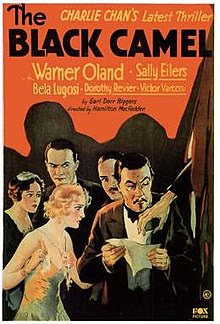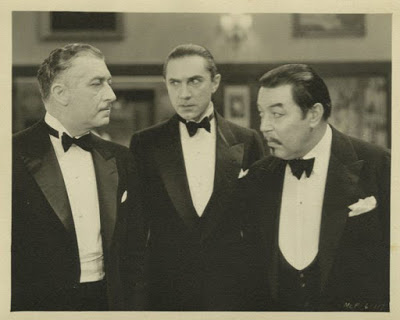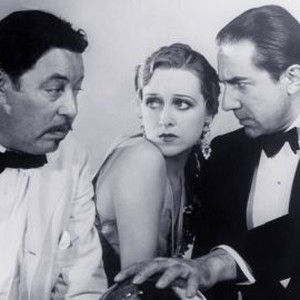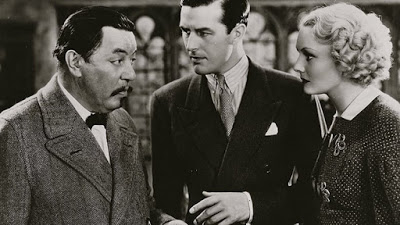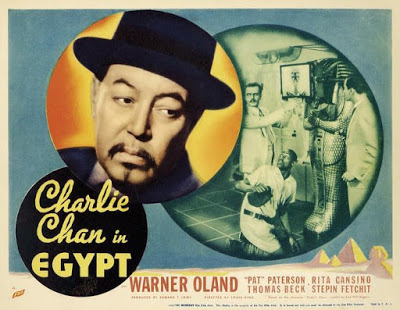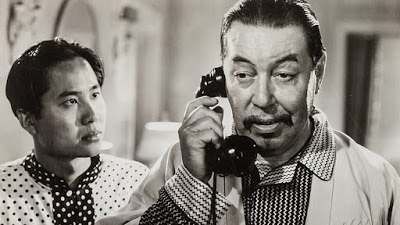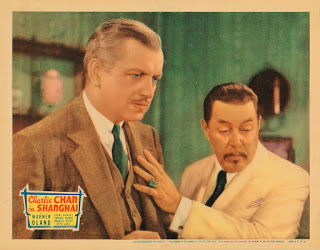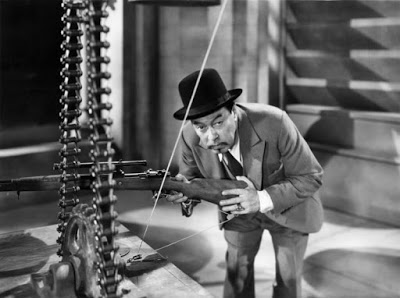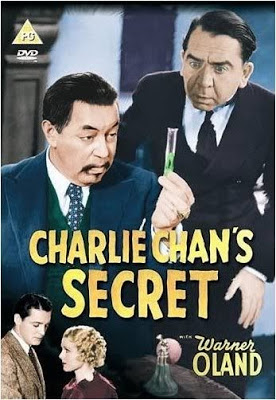Warner Oland as Charlie
Chan - The First Six Films
The Black Camel (1931) – 5.5

Made in 1931, this is the only surviving Charlie Chan film of the first five
that Warner Oland starred in. The others have sadly been lost. These first
five films were based directly on the books of Earl Derr Biggers who died
in 1933 after writing six Charlie Chan books. The next existing Chan/Oland
film was Charlie Chan in London in 1934 and that one plus most of the rest
of the Chan films were not based on the books. In the intervening years between
The Black Camel and Charlie Chan in London film sound techniques had improved
considerably as film transitioned from the silent to the talkies. The Black
Camel has many of the weaknesses of films from that period as it is stagey,
slow and stuck in place as film still had not really mastered sound as a
moving medium. This was really the first Chan film that focused on Charlie
Chan as opposed to almost being a side character. It was Charlie Chan Carries
On (lost film) that increased his popularity even though he only shows up
at the end of the film. So they went with that for this film.
It is an ok film that generally very closely follows the book though the
second murder in the film does not happen in the book. It has a remarkable
cast of unknowns who were to become somewhat famous later on - Oland of course
who took on Chan for many more films until he died in 1938, Robert Young
in his debut as the romantic side story and both Bela Lugosi and Dwight Frye
who had just finished Dracula. Frye had also just finished an early version
of The Maltese Falcon as the character Wilmer.
Chan's police assistant in the film is a Japanese character who is sort of
the comic relief. Fortunately, his sons came along in later films to help
him along with Mantan Moreland. Oddly, the horrible stereotype of this character
is actually taken from the book and is not a Hollywood invention. For some
reason Biggers took quite a dislike to the Japanese - which perhaps for that
time was not unusual but he at the same time showed great respect for the
Chinese culture which was unusual at a time in which America had passed incredibly
discriminatory laws against Chinese immigrants. This disdain for the Japanese
was perhaps caused by the enmity between China and Japan in those times,
but that is just a guess. But today it is really embarrassing to watch -
cringe worthy.
The plot of The Black Camel was brought forth again under slightly different
circumstances in Charlie Chan in Rio made in 1941 with Sidney Toler playing
Chan. In this film a Hollywood movie star is in Hawaii making a film and
fell in love on her way over on the boat. She brings her mentalist (Bela)
over from Hollywood to ask him if marrying this man was a good idea. But
this is all related to a murder that took place three years before of her
lover. It was never solved but it seems the killer must be in Hawaii. Murders
occur, Charlie spits out wise aphorisms by the dozens, a household of suspects
and Bela lurking about. The acting from most of the cast other than Oland
and Lugosi is uniformly dreadful - very monotone or hysterical or as with
the Japanese assistant embarrassing. But a good mystery.
Charlie Chan in London (1934) – 7.0
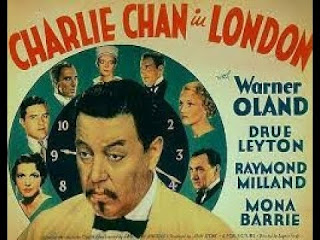
Charlie Chan in London is one of my favorite Chan films with a setting in
England at a country manor that felt very Agatha Christie with a household
of suspects. Fast moving and reasonably suspenseful. There is a solid cast
and Eugene Forde who is fast becoming one of my favorite B directors with
his ability to move things along - and a fine whodunit scripted by Philip
MacDonald.
Chan has three days to find the real murderer or an innocent man will swing.
By the neck. He is about to leave for Hawaii and his wife and 12 children
(how does he find time to solve crimes) when the sister (Drue Layton) of
the sentenced man begs for him to help. Charlie Chan cannot say no to a pretty
lady. At her side is a young unknown Ray Milland acting very much like an
older Ray Milland - charming with just a touch of his Welch accent. Chan
shows up at the manor of Richmond (Alan Mowbray) which was the scene of the
murder three months previously and fortunately all the people who were there
that night are still hanging about. Another murder and two attempted murders
follow but there turns out to be much more at stake than just a man's life.
The clue is the horse that doesn't neigh. But it made no sound Charlie. That
was the curious incident. I was as usual completely in the dark as to the
identity of the killer.
Charlie Chan in Paris (1935) – 6.5

Charlie Chan in Paris is a very solid outing in the series with a script
written by Philip MacDonald who also did the excellent Charlie Chan in London.
In fact, this film follows right on the heels of the London case as Chan
has flown to Paris on another case - of forged bond notes. His contact is
killed before Chan has a chance to meet. But Chan gets the able assistance
of his son who was in Europe on business, which doesn't really jive with
him in later films. He is played by the legendary Keye Luke in his first
credited film and is a very welcome addition. It is a taut little mystery
- partially taking place in the famous sewers of Paris - with a few twists
in there. Warner Oland is still playing Chan and is quite good here with
a nice mix of menace and polite cheer. When one of the characters offers
Chan “a little drinkee drinkee”, the stone cold expression on Chan’s face
says everything.
Back in the 1930’s musicals were so popular that they often threw musical
numbers into other types of films. Some of these are rather enjoyable. In
the film Charlie Chan in Paris there is a dance number that is almost brutal
in its style that was termed an Apache Dance or La Danse Apache. This was
supposed to be a dance re-enaction of a fight between a Parisian pimp and
one of his working girls. The female dancer is Dorothy Appleby who generally
only got small parts in films from the 1930’s to the early 1940’s but a number
of these were in Three Stooges films. She died in 1990. The male dancer is
Fred Wallace, who I can’t find much information on at all.
Charlie Chan in Egypt (1935) – 5.0

Charlie Chan continues his global tour in the 1935 Charlie Chan in Egypt.
The Fox studios had begun placing Charlie in various foreign locations first
in London, then Paris, now Egypt and next in Shanghai in hopes to excite
the audience. In reality of course these films never made it off the studio
lot with a bit of stock footage at the beginning to establish the location.
The choice of location of this and the plot – an archeological dig – was
likely influenced by the success of The Mummy in 1932. This wasn’t as good
as the London and Paris films but it did have the added interest for old
film fans of two of the co-stars.
One was the legendary and today very controversial actor Stepin Fetchit who
became a symbol of a horrible black stereotype that was very demeaning. At
the time though Stepin was in the big time and quite wealthy – this during
the Great Depression mind you – and owned six houses, twelve cars and sixteen
Chinese servants! His character is like hearing claws on a blackboard with
his mumbled yessuhs and nosuhs to modern audiences. In fact, the Chan films
often brought on black actors for comedy relief - and some are fairly funny
even if stereotyped - but Stepin is just painful to have around. His name
became synonymous with being lazy. The other co-star of interest plays an
Egyptian maid with only a bit of dialogue and was still using her old name,
Rita Cansino better known today as Rita Hayworth. She is hard to recognize
but this was before the cosmetologists did a makeover into one of the most
beautiful women in the world.
Egyptologists who open the tombs of Pharaoh's never do well in films. Curses
or death usually await them. And sure enough it happens here. A group has
unearthed the burial site of a Pharaoh and the leader of the excavation ends
up in the Pharaoh's coffin. Dead needless to say. Charlie Chan (Warner Oland)
has been sent from a museum in Paris to look into why artifacts from the
site have ended up in other museums. But a dead man awaits Chan and others
are on deck.
Charlie Chan in Shanghai (1935) – 6.0
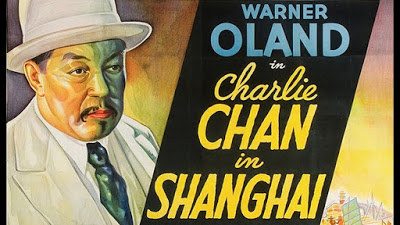
Charlie Chan continues his Trip Around the World Crime Tour. First it was
London, then on to Paris, Egypt and now the mysterious Orient in Shanghai!
This was Warner Oland's ninth appearance as Chan though four of those films
are considered lost. Which is a shame because at least to this point they
are still fairly enjoyable. Oland of course not only made a career out of
playing Chan but other Asians as well. Here he sings a little ditty to some
children on the slow boat to China and in the lyrics he sings about going
to the homeland of Fu Manchu. A little perhaps intentional irony as Oland
had portrayed that quintessential Yellow Peril villain in four films in the
early days of talking movies.
Here Chan is called to Shanghai by a friend but doesn't have any idea why.
As expected this man is killed before he can tell Chan anything at a formal
dinner with the old gun in a box trick that shoots you when you open it.
And then the bad guys try and kill Chan a few times. Fortunately, he has
the aid of his son played by Key Luke again, who we had missed in Egypt.
Luke can of course speak Cantonese and does a few times - though in Shanghai
it should in theory be Mandarin - and Oland gives it a go once and even to
my untrained ears his Chinese was pretty bad. It turns out that Charlie was
called to stop an opium smuggling ring - "The beauty of the poppy conceals
the sting of death".
A few future sort of stars in the cast. Jon Hall as half of the romantic
pair had his first credited film here but within a few years was a star doing
all these exotic adventure films - kind of a male sarong star in films like
The Hurricane, South of Pago Pogo, Aloma of the South Seas, Arabian Nights
and Ali Baba and the Forty Thieves. His romantic partner in this is Irene
Hervey, Aunt Meg in the Honey West series and loads of other TV shows. In
a small part as the telephone operator is Lynn Bari who was "uncredited"
for a few years of struggle in many films but by 1939 was the co-star in
Chan's City of Darkness and went on to star in many mainly B films. And that
dancer in the nightclub scene is Joan Woodbury who also went on to a number
of B films like King of the Zombies, other Chan films and Brenda Starr in
Brenda Star, Reporter.
In an interesting instance of fact meets fiction, Oland had visited Shanghai
right before the film was made and he was welcomed like a hometown hero -
in fact when he spoke at the dinner that they gave him, he said it was wonderful
to visit his homeland. Oland had of course been born in Sweden. This dinner
was then written into the film with a slight difference - in the movie a
murder takes place.
Charlie Chan’s Secret (1936) – 5.5
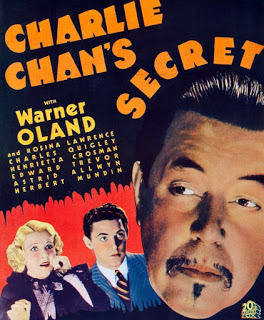
Strange how often medium's featured in so many of the old B films of the
the 1930's and 40's . They must have been a bigger deal back then. Of course
now you don't have to have a physical séance but can just call up
1-800-Sucker to get your fortune told or hear from the dead. In the times
of covid that is relief. The interesting thing about the medium here besides
that she is very attractive is that she is never proved to be a fake even
though her partner is. She believes she communicates with the dead and Charlie
seems to be a believer in that ability as well.
Alan Colby disappeared years ago and during his absence his father died and
he came into a lot of money - but since he was presumed dead the sister of
Colby's father has taken over the fortune and is generously taking care of
her parasite family including the medium. When Colby sends a wire that he
is still alive and coming home, the old lady calls her friend Charlie Chan
in Hawaii to come to California and check that Alan isn't an imposter. The
actor who plays Colby was probably hoping for a meatier role but he is killed
as soon as he shows up by an unknown knife thrower. So Charlie is saddled
with murder as usual and a few attempts at more. With lots of suspects with
motives. Chan rather cleverly figures everything out and sets two traps for
the killer.
Not bad though it feels a little unambitious with a plot that any movie detective
of the time could have handled. Even Number One (Keye Luke) isn't around
to add fun to a fairly somber outing. In his place they give us Baxter the
butler played by the cherubic always bumbling Herbert Mundin, an Englishman
who looks just like his name would indicate. You may recall him from being
one of Robin's men in The Adventures of Robin Hood or the nervous nelly in
Tarzan Escapes. Always enjoy seeing him and hadn't realized till I looked
him up that he died in 1939 in a car crash at the age of 40.
What needs to be remembered is that though we look at the Chan films now
as quaint little nostalgia trips filled with aphorisms and stereotypes -
at the time Charlie Chan - and because of him Warner Oland - were enormously
popular. They were produced by the Fox B Unit headed by Sol Wurtzel but they
were a big deal and very profitable. And in demand. In 1936 they produced
four Chan films and three in 1937 before Oland was to die in 1938 (and quickly
be replaced). At the same time Wurtzel was producing the Mr. Moto films.
Apparently, Yellow Face or Orientalism was a popular trend at the time.
